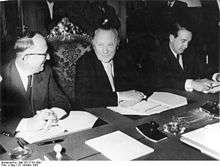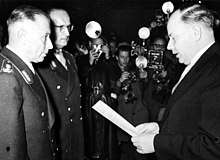West German rearmament
West German rearmament (German: Wiederbewaffnung) refers to the United States program to help rebuild the military of West Germany after World War II. Fears of another rise of German militarism necessitated the new military to operate within an alliance framework, under NATO command.[1] The events led to the establishment of the Bundeswehr, the West German military, in 1955. The name Bundeswehr was a compromise choice suggested by former general Hasso von Manteuffel. The older Wehrmacht term for the combined German forces of Nazi Germany had been vetoed by the American occupational authorities.[2]


Background
The 1945 Morgenthau Plan had called to occupy Germany and remove its ability to wage war by eliminating its arms industry and other key industries essential to military strength.[3] This was in line with the Soviet Union's vision for a post-war Germany, reduced to a pastoral state without heavy industries. However, because of the cost of food imports to Germany, and the fear that poverty and hunger would drive desperate Germans toward communism, the US government signalled a moderation of this plan in September 1946 with Secretary of State James F. Byrnes's speech Restatement of Policy on Germany.[4] While this gave Germans hope for the future, it also evidenced the emergence of the Cold War.
People resent the fact that while the United States followed a policy of German disarmament and of friendship with Russia after the war, it now advocates rearmament they could just as easily argue that it was for cooperation with the Soviet Union and to change its policy.
The vigorous disarmament program in Germany continued by the UK and US for the first three years of occupation.[6] This dismantling of industry became increasingly unpopular and ran contrary to the 1948 Marshall Plan's mission to encourage industrial growth.[7]
On August 29, 1949, the Soviet Union detonated the atomic bomb RDS-1, which forced a reevaluation of the defense requirements of Western Europe. In June 1950, the Korean War began and raised fears in West Germany, with comparisons drawn between the actions of North Korea and the possible actions of East Germany. Both France and the United Kingdom were wary of the revival of German martial potential, having been severely tested in the world wars.[8] American political figures, such as Senator Elmer Thomas, argued that West Germany needed to be included in a defensive system, stating "several divisions of German troops should be armed by the United States without Germany herself being permitted to manufacture arms."[9] German Chancellor Konrad Adenauer was determined to use offers of rearmament to regain sovereignty for West Germany.
During the September 1950 NATO meeting, France decided to become isolated for the rearmament operation because they did not want Germany to join NATO. West Germany wanted to join NATO because of Adenauer's desire to appease the fears of its neighbors and show a willingness to cooperate.[10] Initial skepticism by the US was set aside after Dwight D Eisenhower endorsed the deal, and West Germany agreed to support the operation.[11] One of the better-known attempts to win West Germany the right to re-arm was the European Defense Community (EDC). A modification of the 1950 Pleven Plan, it proposed the raising of West German forces integrated into a European Defense Force. When West Germany embraced an edited plan and the push for rearmament seemed to be assured, France vetoed the attempt in August 1954.[12] In 1955, West Germany joined NATO.
Bundeswehr formation
Neither East nor West Germany had any regular armed forces at the time, though they did have paramilitary police forces (the western Bundesgrenzschutz and eastern Kasernierte Volkspolizei). The Bundeswehr (West German military) was armed originally from Military Assistance Program funds from the US. Former Kriegsmarine ships, seized under the Tripartite Naval Commission, were returned by the US. Slowly, West German sailors were stationed on US Navy ships and West Germany helped to supply the navy. This operation was intended to ensure that West Germany possessed an effective military force. The US supplied the potential sailors with intensive training to help build up the navy for the future as West Germany set a goal to have up to 500,000 men in military service, partly due to Theodor Blank's desire for West Germany to have a more significant military than Italy in order to project power and increase its contributions.[13] To get his point across, he used this chart:
| Country | Peacetime military strength | Percentage of population |
|---|---|---|
| United States | 2,865,000 | 1.8 |
| United Kingdom | 772,000 | 1.5 |
| France | 850,000 | 2.0 |
| Belgium | 145,000 | 1.65 |
| Netherlands | 125,000 | 1.2 |
| West Germany | 500,000 | 1.0 |
To reach that goal, the West German border security force (Bundesgrenzschutz) was transformed into military personnel, utilizing both conscripts and volunteers. West Germany instituted a policy of conscription, despite apprehension that the new fighting force would be compared to the Nazi-era Wehrmacht. Erik Reger, the editor of the Berlin daily Tagesspiegel, was noted as saying "As soon as Germany has soldiers, there will be war",[14] arguing that military support could lead to a rightward shift in national politics. The Social Democrats argued that even though the military was expanded to a positive reception, it would not be enough to revive German militarism.
Among many former German officers, however, there was the conviction that no future German army could be possible without a rehabilitation of the Wehrmacht. To this end, a group of former senior officers gathered on 9 October 1950 at Himmerod Abbey to produce a memorandum for Adenauer, which included these key demands:
- All German soldiers convicted as war criminals (Kriegsverurteilte) would be released
- The defamation of the German soldier, including those from the Waffen-SS, would have to cease
- Measures to assure the welfare of former soldiers and their widows would have to be taken[15]
Adenauer accepted these propositions and in turn advised the representatives of the three Western powers that a German military would not be possible as long as German soldiers remained in custody or were brought before courts. The willingness of the former Allies to commute a number of sentences for incarcerated officers undoubtedly tied back to that condition. In the early months of 1951, public declarations from Eisenhower and other US military officers followed, outlining "a real difference between the German soldier and Hitler and his criminal group".[15]
Bundesmarine formation
The US established the Naval Historical Team (NHT) to help with the Anglo-American World War II naval historical project. Both countries recruited German naval veterans and naval activists to help expand the future West German navy by gaining a better perspective of the previous naval war. However, the NHT soon shifted focus[11] to pursue information about Soviet naval forces. The initial goal was to study the landings and targets of the Soviet navy. This agency became the coordinating staff of the Bundesmarine, the West German navy. Another group of veterans of the former Kriegsmarine, called "labor service units", were assigned to similar tasks of deciphering surveillance. Adenauer created the Blank Office (Amt Blank) to use West German defense contributions as leverage for increased sovereignty.[11] With the different organizations working together, a naval proposal referred to as the Wagner Paper was adopted to use as a negotiation tool at the February 1951 conference of the EDC, held in Paris. However, France forced a deadlock, opposing the threat of naval rearmament. especially as it had perceived links to the Nazi regime. To resolve the issue, the Wagner Paper was sent to the Supreme Headquarters Allied Powers Europe (SHAPE), which was in favor of naval rearmament. France compromised, offering some escort ships and accepting the naval buildup. However, the West German military remained under the supreme allied NATO control, which diminished its command positions.[16]
Effects
The growth of the German Bundeswehr proved a key element in the growth of West German influence in central Europe. This, along with the 1951 Treaty of Paris, cemented the elements of Western European economic cooperation, and helped to integrate post-war West Germany into the European community. At the same time, the Soviet Union used this as a foundational justification to implement the Warsaw Pact, which provided substantial military and political control over key Eastern European states.[17][18]
References
Sources
- Curtis, Glenn. "THE WARSAW PACT." THE WARSAW PACT. Czechoslovakia: A Country Study. 17 Feb 2008
- Guderian, Heinz, Kann Westeuropa verteidigt werden?, Göttingen, 1950; and idem, So geht es nicht, Heidelberg, 1951.
- Halsall, Paul. "TREATY OF FRIENDSHIP, CO-OPERATION AND MUTUAL ASSISTANCE." Modern History Sourcebook. November 1998 . Internet Modern History Sourcebook. 18 Feb 2008
- Large, David K. Germans to the Front: West German Rearmament in the Adenauer Era. (Chapel Hill, University of North Carolina Press, 1996)
- Snyder, David R.," Arming the "Bundesmarine": The United States and the Build-Up of the German Federal Navy, 1950-1960" The Journal of Military History, Vol. 66, No. 2. (Apr., 2002), pp. 477–500.
- Speier, Hans. German Rearmament and Atomic War. Evanston, Illinois: Row, Peterson and Company, 1957.
- Smelser, Ronald; Davies, Edward J. (2008). The Myth of the Eastern Front: the Nazi-Soviet war in American popular culture. New York: Cambridge University Press. ISBN 9780521833653.CS1 maint: ref=harv (link)
Notes
- David R. Snyder, "Arming the Bundesmarine: The United States and the Build-Up of the German Federal Navy, 1950-1960")" The Journal of Military History, Vol. 66, No. 2. (Apr. 2002), pp. 477-500.
- name= David K Large, Germans to the Front: West German Rearmament in the Adenauer Era. (Chapel Hill, University of North Carolina Press, 1996) Pg 243
- Morgenthau, Henry (1945). Germany is our Problem. New York: Harper & brothers.
- Gimbel, John (June 1972). On the Implementation of the Potsdam Agreement: An Essay on U.S. Postwar German Policy. Political Science Quarterly. 87. pp. 242–269. doi:10.2307/2147827. JSTOR 2147827.
- Guderian, Heinz (1950). Kann Westeuropa verteidigt warden? [Can Europe Be Defended?] (in German). Göttingen. OCLC 8977019.
- Balabkins, Nicholas (1964). Germany Under Direct Controls: Economic Aspects of Industrial Disarmament 1945–1948. Rutgers University Press. p. 207.
- Bark, Dennis L.; Gress, David R. (1989). A history of West Germany vol 1: from shadow to substance. Oxford. p. 259.
- Large, David K. (1996). Germans to the Front: West German Rearmament in the Adenauer Era. Chapel Hill, North Carolina: University of North Carolina Press. pp. 3–6.
- C.D.G. Onslow, "West German Rearmament". World Politics, Vol. 3, No. 3. (July, 1951), 450-485. Accessed April 28,2015. doi: jstor.org Archived 2018-07-23 at the Wayback Machine
- Hans Speier, German Rearmament and Atomic War. Evanston, Illinois: Row, Peterson and Company, 1957. 198
- David R. Snyder, "Arming the "Bundesmarine": The United States and the Build-Up of the German Federal Navy, 1950-1960" The Journal of Military History, Vol. 66, No. 2. (Apr., 2002), pp. 477-500.
- David K Large, Germans to the Front: West German Rearmament in the Adenauer Era. (Chapel Hill, University of North Carolina Press, 1996). Pg 4-5
- Hans Speier, German Rearmament and Atomic War. Evanston, Illinois: Row, Peterson and Company, 1957, 196
- name= David K Large, Germans to the Front: West German Rearmament in the Adenauer Era. (Chapel Hill, University of North Carolina Press, 1996) Pg 45
- Smelser & Davies 2008, pp. 72-73.
- Hans Speier, German Rearmament and Atomic War. Evanston, Illinois: Row, Peterson and Company, 1957, 199
- "Halsall, Paul. "TREATY OF FRIENDSHIP, CO-OPERATION AND MUTUAL ASSISTANCE." Modern History Sourcebook. November 1998. Internet Modern History Sourcebook. 18 Feb 2008". Archived from the original on 10 April 2008. Retrieved 18 February 2008.
- "Curtis, Glenn . "THE WARSAW PACT." THE WARSAW PACT. Czechoslovakia: A Country Study. 17 Feb 2008". Archived from the original on 26 February 2008. Retrieved 18 February 2008.